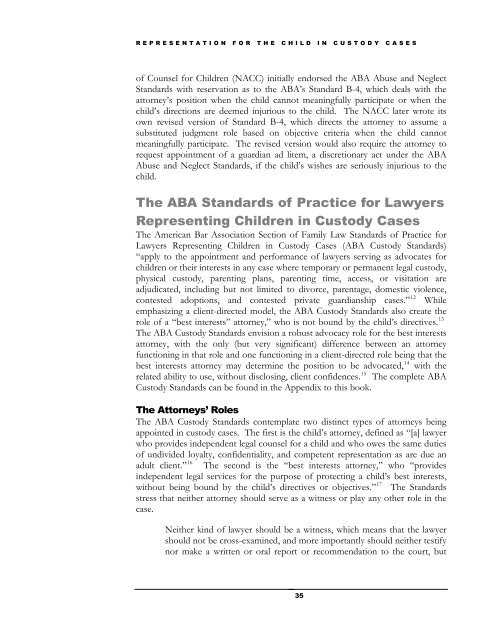A Judge’s Guide
A Judge’s Guide
A Judge’s Guide
You also want an ePaper? Increase the reach of your titles
YUMPU automatically turns print PDFs into web optimized ePapers that Google loves.
REPRESENTATION FOR THE CHILD IN CUSTODY CASES<br />
of Counsel for Children (NACC) initially endorsed the ABA Abuse and Neglect<br />
Standards with reservation as to the ABA’s Standard B-4, which deals with the<br />
attorney’s position when the child cannot meaningfully participate or when the<br />
child’s directions are deemed injurious to the child. The NACC later wrote its<br />
own revised version of Standard B-4, which directs the attorney to assume a<br />
substituted judgment role based on objective criteria when the child cannot<br />
meaningfully participate. The revised version would also require the attorney to<br />
request appointment of a guardian ad litem, a discretionary act under the ABA<br />
Abuse and Neglect Standards, if the child’s wishes are seriously injurious to the<br />
child.<br />
The ABA Standards of Practice for Lawyers<br />
Representing Children in Custody Cases<br />
The American Bar Association Section of Family Law Standards of Practice for<br />
Lawyers Representing Children in Custody Cases (ABA Custody Standards)<br />
“apply to the appointment and performance of lawyers serving as advocates for<br />
children or their interests in any case where temporary or permanent legal custody,<br />
physical custody, parenting plans, parenting time, access, or visitation are<br />
adjudicated, including but not limited to divorce, parentage, domestic violence,<br />
contested adoptions, and contested private guardianship cases.” 12 While<br />
emphasizing a client-directed model, the ABA Custody Standards also create the<br />
role of a “best interests” attorney,” who is not bound by the child’s directives. 13<br />
The ABA Custody Standards envision a robust advocacy role for the best interests<br />
attorney, with the only (but very significant) difference between an attorney<br />
functioning in that role and one functioning in a client-directed role being that the<br />
best interests attorney may determine the position to be advocated, 14 with the<br />
related ability to use, without disclosing, client confidences. 15 The complete ABA<br />
Custody Standards can be found in the Appendix to this book.<br />
The Attorneys’ Roles<br />
The ABA Custody Standards contemplate two distinct types of attorneys being<br />
appointed in custody cases. The first is the child’s attorney, defined as “[a] lawyer<br />
who provides independent legal counsel for a child and who owes the same duties<br />
of undivided loyalty, confidentiality, and competent representation as are due an<br />
adult client.” 16 The second is the “best interests attorney,” who “provides<br />
independent legal services for the purpose of protecting a child’s best interests,<br />
without being bound by the child’s directives or objectives.” 17 The Standards<br />
stress that neither attorney should serve as a witness or play any other role in the<br />
case.<br />
Neither kind of lawyer should be a witness, which means that the lawyer<br />
should not be cross-examined, and more importantly should neither testify<br />
nor make a written or oral report or recommendation to the court, but<br />
35


